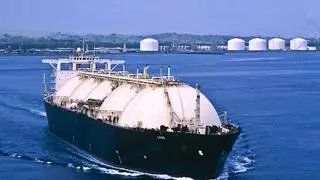Tata Steel has piloted a new process for production of steel, one it says “results in enormous efficiency gains” and reduces energy use and carbon dioxide emissions by a fifth of that in the conventional blast furnace route.
The company has tested this “completely new technology for producing steel” in five pilot plants in Europe; the next step is to bring a commercial scale plant to India.
The process, called HIsarna, is a combination of Isarna and Hismelt, the Celtic words for iron and melting vessel, respectively. The company has spent $75 million in developing the technology at its steel plant in Ijmuiden, The Netherlands.
In a conventional blast furnace, the ‘flux’ – a mixture of iron ore, coke and limestone – is put into the furnace and a blast of oxygen is sent in through a lance. The mixture melts and collects at the bottom. In HIsarna, the ore is liquefied in a high-temperature cyclone at the top and the molten ore drips to the bottom of the reactor, where powder coal is injected.
“The technology removes a number of pre-processing steps and requires less stringent conditions on the quality of the raw materials used,” says a Tata Steel note on the technology. Since it is highly concentrated carbon dioxide that leaves the reactor, the system is “ideally suited for carbon capture and either storage (CCS) or use (CCU), without the need for a costly gas separation stage.”
The combination of HIsarna with storage could slash slash carbon dioxide emissions by 80 per cent, compared with that in the conventional steel production process, the company says.
Also read: Tata Steel sales volume up in December quarter
A spokesperson of Tata Steel, told BusinessLine that the company is “currently in the process of upscaling the design towards commercial scale”. He said the company intends to have the first scaled-up plant in India, and subsequently build a commercial plant in Ijmuiden.
“The commercialisation of the process will require significant engineering efforts and investment,” the spokesperson said. Asked about the investments that a commercial plant would require, he said that would depend upon the “location, existing infrastructure and the desired configuration”.
Engineering teams in India and Europe were working together “to ensure earliest realisation at both locations,” the spokesperson said.
The steel industry is among the largest emitters of carbon dioxide, the prime culprit in global warming. A recent report by The Energy and Resources Institute (TERI), one of India’s leading research bodies, noted that the Indian steel sector would likely triple its carbon footprint by 2020, given the need to produce more steel.
TERI estimates that CO2 emissions from the steel industry would jump to 837 million tonnes over the next three decades from 242 million tonnes now, as India’s steel consumption quadruples to about 500 million tonnes.
India has 977 steel plants currently, which are likely to be very busy as the country upgrades its infrastructure, spending $ 1.5 trillion over the next five years.
Tata Steel expects HIsarna would “play a pivotal role in meeting the future recycling ambitions of the circular economy.”
The company puts it thus: “Not only do we expect to be able to combine primary steelmaking with recycling of up to 50 per cent steel scrap, which is twice the present theoretical maximum of the Blast Furnace – Basic Oxygen Steel plant route. HIsarna also allows the recovery of zinc from coated steel scrap.”







Comments
Comments have to be in English, and in full sentences. They cannot be abusive or personal. Please abide by our community guidelines for posting your comments.
We have migrated to a new commenting platform. If you are already a registered user of TheHindu Businessline and logged in, you may continue to engage with our articles. If you do not have an account please register and login to post comments. Users can access their older comments by logging into their accounts on Vuukle.